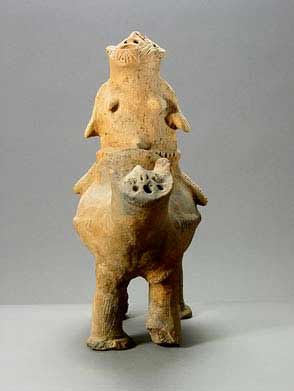Dakakari Terracotta Animal and Rider, 18th Century CE - 20th Century CE
Terracotta
20.875 x 18.25
PF.5138 (LSO)
Further images
This enigmatic object representing an animal and rider was made by the Dakakari people. It is a somewhat mystifying animal, demonstrating the characteristics of various real creatures. The body of...
This enigmatic object representing an animal and rider was made by the Dakakari people. It is a somewhat mystifying animal, demonstrating the characteristics of various real creatures. The body of the mount is globular, with large, columnar legs and a long neck that gives way to a very reduced head with contracted features and small ears. The flanks are marked with a line of vertical dashes on each side. It bears a saddle in a vaguely boat shape, which supports the rider. He is massively built, with a thick torso, short limbs and an upward-looking face with only the vaguest anthropomorphic detailing. The face and what appear to be wings are marked with incisions, as is the garment (?) around the waist. It is the most remarkable configuration. The clay is pale in colour, and very hard-fired. There are some remnants of pigment here and there on the body. The position of the feet indicates that it may once have been attached to a spherical vessel; the reason for this is explained below.
The Dakakiri peoples of NW Nigeria are a little-studied group that are primarily known for their unusual funerary traditions. The standard practice was to bury individuals with a range of plain pottery for their use in the afterlife. However, it is the burials of the higher status individuals from the tribe – including their chiefs and their retinue – that give rise to the production of the Dakakiri’s major contribution to the corpus of African art history. Prestige individuals are buried in stone-lined shaft tombs; the sealed tops of these tombs are ringed around with stone walls to create a small enclosure.
Skilled potters are then commissioned to create sculptural vessels, with plain, spherical bases that are buried into the underlying soil, and with anthropomorphic or zoomorphic superstructures that commemorate the deceased. The deceased are venerated annually by pouring libations of maize flour or beer over the pots. The trade was usually kept within families; experience was all-important – the most prestigious potters were often post-menopausal women. Every person who dies in an elite family has another piece – or pieces – dedicated to them and placed within the superstructure over time, these collections can build up considerably, marking the development of the family throughout generations.
Animals such as goats and elephants are known for this group, but this is clearly a somewhat stylised or even imaginary beast. It is possible that it reflects some mythological or historical aspect of Dakakari life, but without fiuther research it is impossible to be more definite. Whatever its reason for existence, however, this is a rare and impressive piece of African art.
The Dakakiri peoples of NW Nigeria are a little-studied group that are primarily known for their unusual funerary traditions. The standard practice was to bury individuals with a range of plain pottery for their use in the afterlife. However, it is the burials of the higher status individuals from the tribe – including their chiefs and their retinue – that give rise to the production of the Dakakiri’s major contribution to the corpus of African art history. Prestige individuals are buried in stone-lined shaft tombs; the sealed tops of these tombs are ringed around with stone walls to create a small enclosure.
Skilled potters are then commissioned to create sculptural vessels, with plain, spherical bases that are buried into the underlying soil, and with anthropomorphic or zoomorphic superstructures that commemorate the deceased. The deceased are venerated annually by pouring libations of maize flour or beer over the pots. The trade was usually kept within families; experience was all-important – the most prestigious potters were often post-menopausal women. Every person who dies in an elite family has another piece – or pieces – dedicated to them and placed within the superstructure over time, these collections can build up considerably, marking the development of the family throughout generations.
Animals such as goats and elephants are known for this group, but this is clearly a somewhat stylised or even imaginary beast. It is possible that it reflects some mythological or historical aspect of Dakakari life, but without fiuther research it is impossible to be more definite. Whatever its reason for existence, however, this is a rare and impressive piece of African art.







